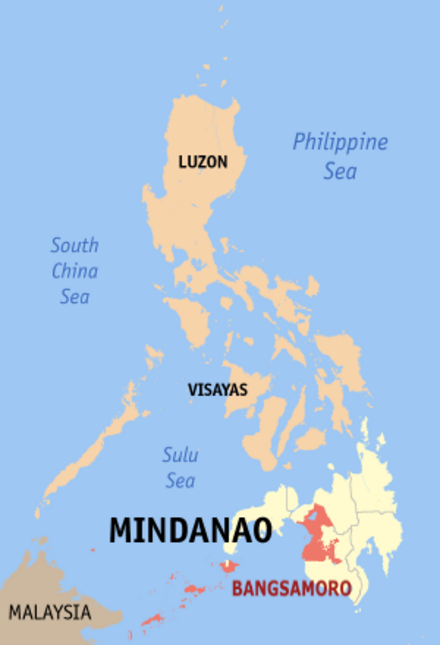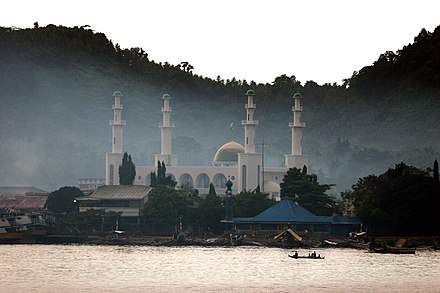Bangsamoro - region in the Philippines
Many governments have issued warnings against all travel to this region because of terrorist activity and clashes between the military and insurgent groups.
Bangsamoro, or Bangsamoro Autonomous Region in Muslim Mindanao (BARMM) in full, is a Muslim-dominant region of Mindanao. The region once formed the Autonomous Region in Muslim Mindanao (ARMM), renamed after a plebiscite in January 2019.
Provinces, cities and islands

- Cotabato City is the regional center of the BARMM.
The BARMM includes the three provinces of the Sulu Islands:
- Basilan
- Isabela City – the regional center of Basilan, with a mix of Christian and Muslim Filipino culture and some undiscovered sights.
- Lamitan
- Tawi-Tawi
- Sulu
plus two provinces on Mindanao Island:
-
- Marawi — capital of the province
- Wao
- Malabang
- Tugaya — the only community in the province that produces excellent brassware. Practically every family has a bellow in the area where the metals are smelted. Using the cire perdule or lost wax technique, cannons and gongs, betelnut boxes and rice pots are made.
It includes 63 barangays in six towns in the province of Cotabato, with the province and the towns themselves still considered part of the Soccsksargen region.
Other areas, such as the Zamboanga Peninsula, have a Muslim majority and some, such as Palawan, have substantial Muslim minorities. When the ARMM was formed these regions were offered the chance to join it, but voted not to.
The provinces covered remain the same after January 2019, when the region succeeded ARMM, but will involve the addition of other Muslim-majority areas including Lanao del Norte (except Iligan) and some border towns in North Cotabato. Lanao del Norte voted no for inclusion, but some barangays in the border towns in North Cotabato voted in favor.
Understand
The region has a distinctive Muslim majority and a colorful culture different from the rest of the Philippines; however, it is also the least developed region of the country, despite being given more autonomy. Muslims, Christians and indigenous peoples lived peacefully, but deep-running resentment by Islamist militants have resulted to the ongoing conflict that affected Mindanao as well. Skirmishes continued to occur on many areas of the region, and terrorist attacks have spilled over into the nearby regions, especially Soccsksargen.
The original Autonomous Region of Muslim Mindanao was formed in response to hostilities led by the Islamic nationalist Moro National Liberation Front (MNLF), which flourished during the 1970s. The provinces of Lanao del Sur, Maguindanao, Sulu, and Tawi-tawi joined the new region, which was inaugurated in 1990. The capital is proposed to be in Parang, but no government buildings have been built, and Cotabato City is made the de facto capital instead. Another plebiscite expanded the region to include Marawi and Basilan (except Isabela city).
A fierce armed conflict between Muslim militia and the Philippine government went on in this region from the 1970s well into the new century. In 2009 this region, then the ARMM, was declared the world's most hazardous area for journalists by the Committee to Protect Journalists, with 18 reporters dead in a massacre that claimed the lives of almost 60 people.
In 2012 a peace accord was signed between the government and the most important militia group, the Moro Islamic Liberation Front or MILF, and things have certainly been calmer since then. However, there are other militia groups that have not signed on to the peace deal; they are mostly quite small but also well-armed and quite radical, so they pose a significant threat.
In May 2017, martial law was imposed on all of Mindanao; people had been killed and buildings set ablaze by factions supporting Da'esh (ISIS) in Marawi. The martial law period has since been extended to the end of 2019.
A plebiscite was held in January 25 and February 6, 2019, but Bangsamoro succeeded the ARMM since the first plebiscite de facto, and the regional government is in transition to a parliamentary system, expected to be completed by 2022.
See also Mindanao#Understand for background information.
Talk
The most-spoken native languages of the Moros are Maguindanaon, Tausūg and Maranao. The Maguindanaoan language is spoken in the Maguindanao province, the Maranao language is majority spoken in Lanao del Sur, and the Tausug is spoken in the Sulu islands. Chavacano, a Spanish-based creole, is also spoken in Basilan, especially in Christian-majority Isabela City
Get in
By plane
Most visitors will enter via the regional capital at Cotabato City. There is only one major airport, Cotabato Airport (IATA: CBO). , which serves Cotabato City but is at the town of Datu Odin Sinsuat in Maguindanao. PAL Express and Cebu Pacific has flights from Manila, while Cebgo has flights from Zamboanga City. The island provinces of Sulu and Tawi-tawi has airports at Jolo (IATA: JOL) and Bongao (IATA: TWT), respectively; the other islands having smaller airports more catered to small aircraft. As most visitors to Bangsamoro are humanitarian workers serving people affected by the insurgency, you may be asked by airport staff if you work for any non-governmental organization if you come by plane.
By bus
The region is less served by buses; Mindanao Star provides bus service from Davao City to Cotabato City, Rural Transit has buses from Cagayan de Oro and Pagadian to Cotabato City, and Husky Tours has buses from General Santos.
By car
The BARMM is served by the Pan-Philippine Highway (Route 1 or AH26), but is unnumbered except for a short segment in Cotabato City. Other highways are Davao-Cotabato Road (Route 76) from Digos and Kidapawan, and Tacurong-Midsayap Road (Route 940) from Tacurong, which bypasses the Pan-Philippine Highway to the east. All highways become unnumbered as they enter the BARMM, and there are military and police checkpoints at entry points.
Get around
Roads in the region are poorly maintained; there are more motorcycles and tricycles than cars. Boats are the only way to get around the island provinces of Basilan, Sulu and Tawi-tawi. There are few to no jeepney; buses, UV Express (van shuttles) or habal-habal are the only practical way to get between towns.
See


- Masjid Dimaukom (Pink Mosque)
Do
Eat
Drink
Stay safe
There remain significant risks for travel in the region; the political situation has been unstable for many years and remains dangerous. Most foreign governments advise tourists to avoid unneccessary travel to the region because of ethnic-religious tension. In some cases, foreigners who visited the region have been abducted or killed by separatist insurgents, including two Canadians beheaded by the Islamic separatist group Abu Sayyaf. Military presence and operations prevail in many areas, and there are chances of being an unintended victim of insurgent attacks.
Respect
Most local laws in this region are based on Sharia: alcoholic drinks, pork and homosexuality are banned. As a Muslim-majority region, dress code in Bangsamoro is more conservative than in most of the Philippines. Women may need to wear a hijab, but this is not required for non-Muslims. Legs and arms may need to be covered completely. Dressing like a tourist can not only call unwanted attention; it may expose you also to the danger of kidnap for ransom by rebel groups.